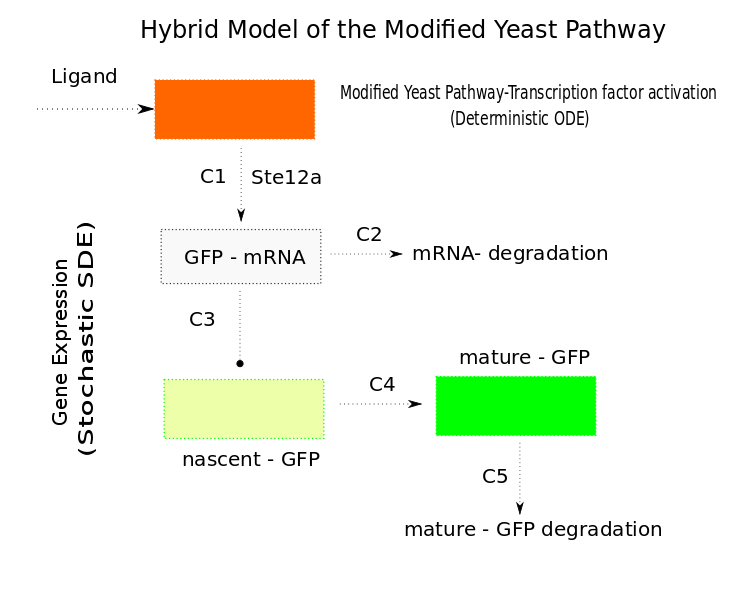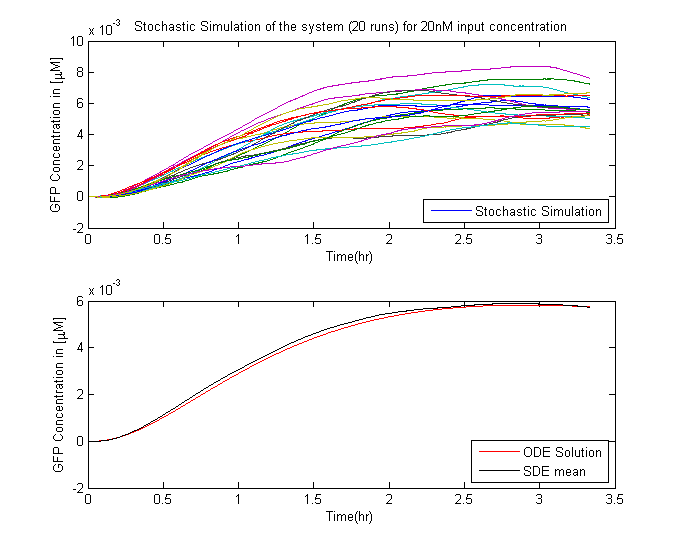Team:TU-Delft/Modeling/StochasticSensitivitySpecificityAnalysis
From 2012.igem.org
(Difference between revisions)
| Line 11: | Line 11: | ||
</center> | </center> | ||
| - | </body></html> | + | </body> |
| + | </html> | ||
__NOEDITSECTION__ | __NOEDITSECTION__ | ||
| Line 17: | Line 18: | ||
Biological functions are inherently stochastic in nature, which leads to a wide degree of variability not only at the population level but also at the level of individual cells, which makes it important to test the reliability of our system. Towards this, we first built a stochastic model of the pathway and then used it to assess the specificity and the sensitivity of our device. | Biological functions are inherently stochastic in nature, which leads to a wide degree of variability not only at the population level but also at the level of individual cells, which makes it important to test the reliability of our system. Towards this, we first built a stochastic model of the pathway and then used it to assess the specificity and the sensitivity of our device. | ||
</div> | </div> | ||
| - | |||
| - | |||
| + | <div id="contentbox" style="text-align:justify;"> | ||
| + | __TOC__ | ||
= Stochastic Model = | = Stochastic Model = | ||
In Saccharomyces cerevisiae, stochasticity (noise) arising from transcription contributes significantly to the level of heterogeneity within a eukaryotic clonal population [[Team:TU-Delft/Modeling/SingleCellModel#Ref7|[7]]].[[File:TUDHybridModel.png|400px|left|thumb|'''Figure 11''': Hybrid model of the modified yeast pathway]] In order to investigate the effects of this stochasticity, we decided to build a stochastic model of the pathway using a '''Hybrid ODE-SDE''' framework (where SDE stands for stochastic differential equation). Data from [[Team:TU-Delft/Modeling/SingleCellModel#Ref7|[5]]] suggests that the Pheromone signalling is robust against cell to cell variations. Motivated by this fact, we assume the dynamics until the activation of the transcription factor to be deterministic rather than stochastic. As a result of the gene expression being noisy, we build a hybrid stochastic model consisting of deterministic semantics until the activation of the transcription factor ''Ste12'' and treat it as a time varying parameter modulating the reaction based gene expression module interpreted with stochastic semantics using the stochastic differential equations approach [[Team:TU-Delft/Modeling/SingleCellModel#Ref7|[8]]], the schematic of which is given in Figure 11. | In Saccharomyces cerevisiae, stochasticity (noise) arising from transcription contributes significantly to the level of heterogeneity within a eukaryotic clonal population [[Team:TU-Delft/Modeling/SingleCellModel#Ref7|[7]]].[[File:TUDHybridModel.png|400px|left|thumb|'''Figure 11''': Hybrid model of the modified yeast pathway]] In order to investigate the effects of this stochasticity, we decided to build a stochastic model of the pathway using a '''Hybrid ODE-SDE''' framework (where SDE stands for stochastic differential equation). Data from [[Team:TU-Delft/Modeling/SingleCellModel#Ref7|[5]]] suggests that the Pheromone signalling is robust against cell to cell variations. Motivated by this fact, we assume the dynamics until the activation of the transcription factor to be deterministic rather than stochastic. As a result of the gene expression being noisy, we build a hybrid stochastic model consisting of deterministic semantics until the activation of the transcription factor ''Ste12'' and treat it as a time varying parameter modulating the reaction based gene expression module interpreted with stochastic semantics using the stochastic differential equations approach [[Team:TU-Delft/Modeling/SingleCellModel#Ref7|[8]]], the schematic of which is given in Figure 11. | ||
Revision as of 23:32, 26 October 2012


Biological functions are inherently stochastic in nature, which leads to a wide degree of variability not only at the population level but also at the level of individual cells, which makes it important to test the reliability of our system. Towards this, we first built a stochastic model of the pathway and then used it to assess the specificity and the sensitivity of our device.
Contents |
Stochastic Model
In Saccharomyces cerevisiae, stochasticity (noise) arising from transcription contributes significantly to the level of heterogeneity within a eukaryotic clonal population [7]. In order to investigate the effects of this stochasticity, we decided to build a stochastic model of the pathway using a Hybrid ODE-SDE framework (where SDE stands for stochastic differential equation). Data from [5] suggests that the Pheromone signalling is robust against cell to cell variations. Motivated by this fact, we assume the dynamics until the activation of the transcription factor to be deterministic rather than stochastic. As a result of the gene expression being noisy, we build a hybrid stochastic model consisting of deterministic semantics until the activation of the transcription factor Ste12 and treat it as a time varying parameter modulating the reaction based gene expression module interpreted with stochastic semantics using the stochastic differential equations approach [8], the schematic of which is given in Figure 11.Twenty simulations were done for each three different input concentrations. The results of which are in the figure below.
conclusion
- The mean of the stochastic simulation runs closely follow the deterministic solutions.
- It helped us assess the degree of variablity that is present within the system
- The time duration of the project limited further applications of this model, the proposed use of which is presented in the future works section.
 "
"



